1. Video Introduction: Oxidative Phosphorylation, the ETC, Chemiosmosis, and ATP Synthase
Start with this video introduction. Here are the key moments
- At 1:00 the video starts with a review of where in the cell the various phases of cellular respiration occur.
- At 2:11 you can find a review of oxidation and reduction.
- At 4:28 new material related to the electron transport chain begins.
- At 7:37 there’s an overview of all of cellular respiration.
2. NADH and FADH2 power the electron transport chain
In the preceding tutorials, we’ve seen how glycolysis, the link reaction, and the Krebs cycle oxidize food, reducing the mobile electron carriers NAD+ and FAD to NADH and FADH2, respectively.
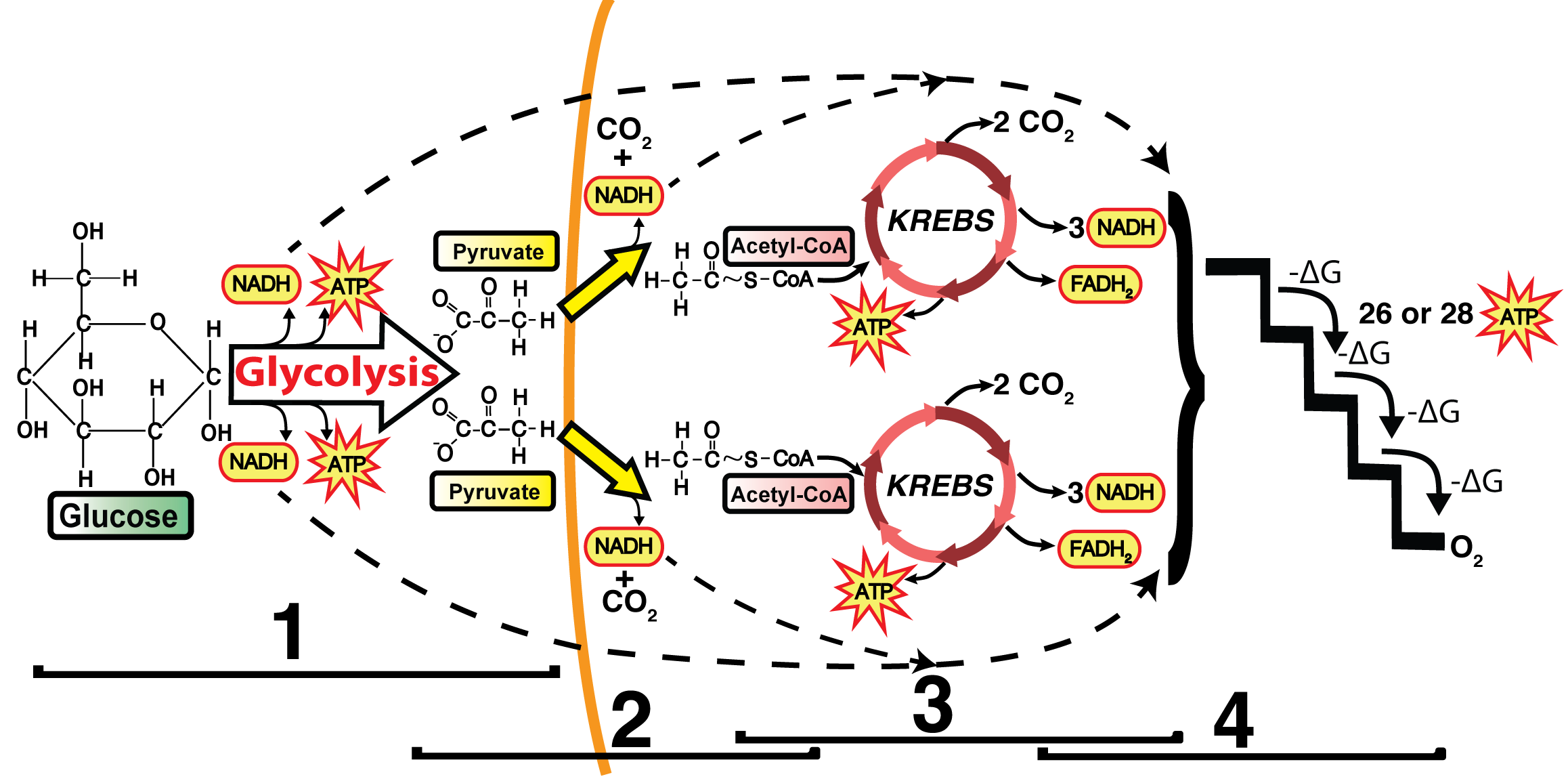
NADH and FADH2 can be thought of as fully charged batteries. If you place a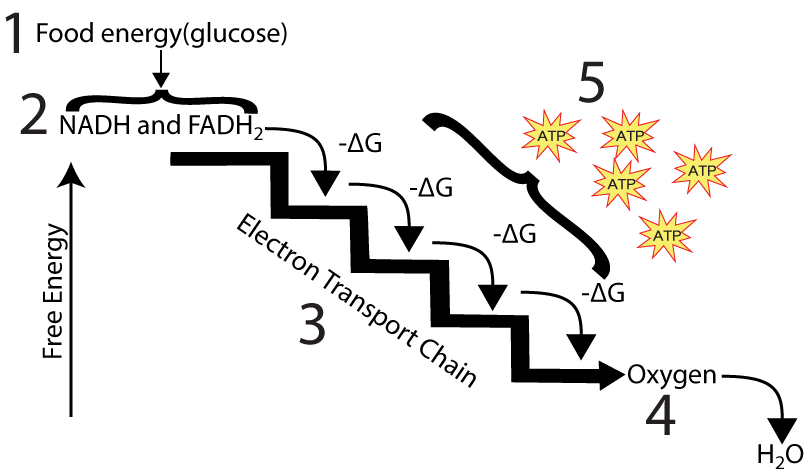 charged battery in a flashlight or a radio,
charged battery in a flashlight or a radio, 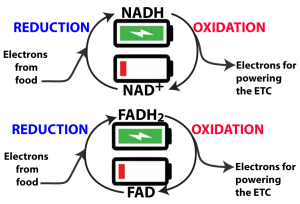 that battery can release a flow of electrical energy that can power some work: providing light in the case of the flashlight or converting radio waves into sound in the case of the radio.
that battery can release a flow of electrical energy that can power some work: providing light in the case of the flashlight or converting radio waves into sound in the case of the radio.
In cells, an analogous thing happens. As shown in a schematic form on the left, NADH and FADH2 deliver electrons to the electron transport chain, a series of proteins that are embedded in the inner membrane of the mitochondria. As electrons flow along the chain, the proteins in the chain do the work of setting up the conditions for ATP creation.
3. Mitochondria: Structure and Function
ATP synthesis in the mitochondria is an example of one of biology’s most important ideas: the relationship between structure and function. The quiz below will let you master the key structures involved. Then we’ll move on to the process.
[qwiz qrecord_id=”sciencemusicvideosMeister1961-Mitochondria S and F (2.0)”]
[h]Interactive Diagrams: Mitochondrial Structure
[i]
[q labels = “top”]
[l]cell exterior
[f*] Excellent!
[fx] No, that’s not correct. Please try again.
[l]cell membrane
[f*] Excellent!
[fx] No. Please try again.
[l]cytoplasm
[f*] Excellent!
[fx] No, that’s not correct. Please try again.
[l]inner membrane
[f*] Good!
[fx] No. Please try again.
[l]intermembrane space
[f*] Good!
[fx] No, that’s not correct. Please try again.
[l]matrix
[f*] Excellent!
[fx] No, that’s not correct. Please try again.
[l]mitochondrion
[f*] Correct!
[fx] No. Please try again.
[l]outer membrane
[f*] Correct!
[fx] No. Please try again.
[q labels = “top”]
Here’s a more realistic depiction of a mitochondrion. You should be able to label all of the parts, with the possible exception of one. ATP Synthase is a protein channel and an enzyme that’s embedded in the mitochondrial membrane. See if you can figure it out as you label the diagram below.
[l]ATP Synthase
[f*] Excellent!
[fx] No, that’s not correct. Please try again.
[l]chromosome
[f*] Great!
[fx] No. Please try again.
[l]cytoplasm
[f*] Good!
[fx] No, that’s not correct. Please try again.
[l]inner membrane
[f*] Great!
[fx] No, that’s not correct. Please try again.
[l]intermembrane space
[f*] Excellent!
[fx] No. Please try again.
[l]matrix
[f*] Good!
[fx] No. Please try again.
[l]outer membrane
[f*] Great!
[fx] No, that’s not correct. Please try again.
[q] Now we’re going to zoom in on the outer boundary of the mitochondrion. Just focus on the letters (you’ll learn about all the numbered parts later). Which letter is the inner membrane?
[textentry single_char=”true”]
[c]IE Q=
[f]IEV4Y2VsbGVudC4gJiM4MjIwO0QmIzgyMjE7IGlzIHRoZSBpbm5lciBtaXRvY2hvbmRyaWFsIG1lbWJyYW5lLg==[Qq]
[c]IEVudGVyIHdvcmQ=[Qq]
[c]ICo=[Qq]
[f]IE5vLiBIZXJlJiM4MjE3O3MgYSBoaW50OiBub3RpY2UgdGhhdCB0aGVyZSBhcmUgdHdvIGxpcGlkIGJpbGF5ZXJzLiBJZiAmIzgyMjA7QSYjODIyMTsgaXMgdGhlIGN5dG9wbGFzbSwgd2hpY2ggbWVtYnJhbmUgaGFzIHRvIGJlIHRoZSBpbm5lciBtZW1icmFuZT8=[Qq]
[q] Which letter is the outer membrane?
[textentry single_char=”true”]
[c]IE I=
[f]IEV4Y2VsbGVudC4gJiM4MjIwO0ImIzgyMjE7IGlzIHRoZSBvdXRlciBtaXRvY2hvbmRyaWFsIG1lbWJyYW5lLg==[Qq]
[c]IEVudGVyIHdvcmQ=[Qq]
[c]ICo=[Qq]
[f]IE5vLiBIZXJlJiM4MjE3O3MgYSBoaW50OiBub3RpY2UgdGhhdCB0aGVyZSBhcmUgdHdvIGxpcGlkIGJpbGF5ZXJzLiBJZiAmIzgyMjA7QSYjODIyMTsgaXMgdGhlIGN5dG9wbGFzbSwgd2hpY2ggbWVtYnJhbmUgaGFzIHRvIGJlIHRoZSBvdXRlciBtZW1icmFuZT8=[Qq]
[q] Which letter indicates the inter-membrane space?
[textentry single_char=”true”]
[c]IE M=
[f]IEV4Y2VsbGVudC4gJiM4MjIwO0MmIzgyMjE7IGlzIHRoZSBpbnRlci1tZW1icmFuZSBzcGFjZS4=[Qq]
[c]IEVudGVyIHdvcmQ=[Qq]
[c]ICo=[Qq]
[f]IE5vLiBIZXJlJiM4MjE3O3MgYSBoaW50OiBub3RpY2UgdGhhdCB0aGVyZSBhcmUgdHdvIGxpcGlkIGJpbGF5ZXJzLiBXaGljaCByZWdpb24gbXVzdCBiZSB0aGUgc3BhY2UgYmV0d2Vlbg==IHRoZXNlIHR3byBtZW1icmFuZXMsIGFsc28ga25vd24gYXMgdGhlICYjODIyMDtpbnRlci1tZW1icmFuZSBzcGFjZS4mIzgyMjE7[Qq]
[q] Which letter indicates the cytoplasm?
[textentry single_char=”true”]
[c]IE E=
[f]IEV4Y2VsbGVudC4gJiM4MjIwO0EmIzgyMjE7IGlzIHRoZSBjeXRvcGxhc20u[Qq]
[c]IEVudGVyIHdvcmQ=[Qq]
[c]ICo=[Qq]
[f]IE5vLiBIZXJlJiM4MjE3O3MgYSBoaW50OiBub3RpY2UgdGhhdCB0aGVyZSBhcmUgdHdvIGxpcGlkIGJpbGF5ZXJzLiBXaGljaCByZWdpb24gaXMgb3V0c2lkZSBvZiB0aGUgb3V0ZXIgbWVtYnJhbmUgKGFuZCBtdXN0LCB0aGVyZWZvcmUsIGJlIHRoZSBjeXRvcGxhc20pPw==[Qq]
[q] Which letter indicates the mitochondrial matrix?
[textentry single_char=”true”]
[c]IE U=
[f]IEV4Y2VsbGVudC4gJiM4MjIwO0UmIzgyMjE7IGlzIHRoZSBtaXRvY2hvbmRyaWFsIG1hdHJpeC4=[Qq]
[c]IEVudGVyIHdvcmQ=[Qq]
[c]ICo=[Qq]
[f]IE5vLiBIZXJlJiM4MjE3O3MgYSBoaW50OiBub3RpY2UgdGhhdCB0aGVyZSBhcmUgdHdvIGxpcGlkIGJpbGF5ZXJzLiBXaGljaCByZWdpb24gaXMgaW5zaWRlIG9mIHRoZSBpbm5lciBtZW1icmFuZSAoYW5kIG11c3QsIHRoZXJlZm9yZSwgYmUgdGhlIG1hdHJpeCwgd2hpY2ggaXMgdGhlIGN5dG9wbGFzbSBvZiB0aGUgbWl0b2Nob25kcmlvbik/[Qq]
[/qwiz]
4. It starts with pumping protons
So, that’s the overall structure. Let’s focus on the electron transport chain, in the inner mitochondrial membrane.
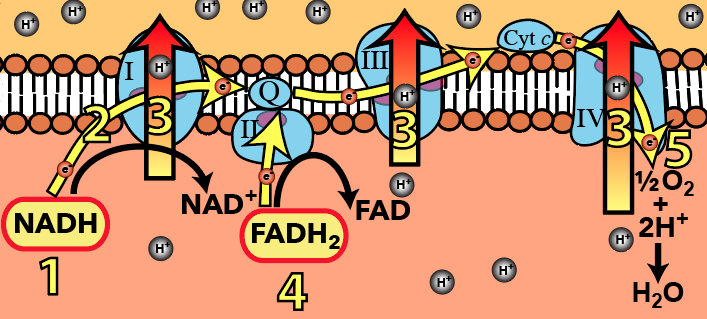
The chain is a series of protein complexes organized along the inner mitochondrial membrane. You can imagine these protein complexes as a type of “molecular wire” that allows electrons donated by NADH and FADH2 to flow.
The electron flow pathway is shown at number “2,” with “1” being electron donation by NADH, and “4” being electron donation by FADH2. Each of these donations is an oxidation that results in NADH becoming NAD+, and FADH2 becoming FAD.
At the very end of the chain (at “5”), electrons flow to oxygen. As oxygen accepts electrons, it also grabs protons from the matrix. This reduces oxygen to water, the second waste product of cellular respiration.
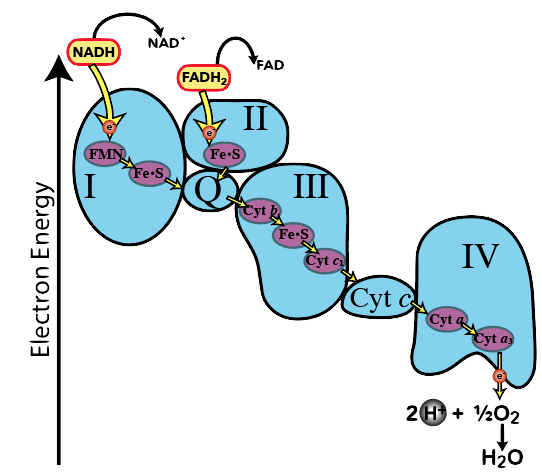 An important feature of the electron transport chain is that the electron carriers are organized in terms of electronegativity. Electronegativity is “the tendency to acquire electrons.” As you move along the electron transport chain, each electron carrier has a greater electronegativity than the one before it. You can see this in the diagram to the left. Inside Complex I you can see the electron carriers FMN and FE.S, which are positioned next to “Q.” “Q” can pull electrons from FE.S, because “Q” has greater electronegativity. FE.S can, in turn, pull electrons from FMN.
An important feature of the electron transport chain is that the electron carriers are organized in terms of electronegativity. Electronegativity is “the tendency to acquire electrons.” As you move along the electron transport chain, each electron carrier has a greater electronegativity than the one before it. You can see this in the diagram to the left. Inside Complex I you can see the electron carriers FMN and FE.S, which are positioned next to “Q.” “Q” can pull electrons from FE.S, because “Q” has greater electronegativity. FE.S can, in turn, pull electrons from FMN.
You can imagine electrons falling “down” an energy gradient. As they fall, they release energy that can be harvested to do work.
Looking at this diagram, we can see why oxygen is so important in this last phase of cellular respiration. Oxygen is the final electron acceptor in the electron transport chain. Its electronegativity pulls electrons down the chain. Without oxygen, electrons don’t flow. And if electrons don’t flow, the work that makes ATP synthesis possible won’t happen. Life, very quickly, grinds to a halt.
And what is this work? The work is pumping protons from the mitochondrial matrix (shown here below the inner 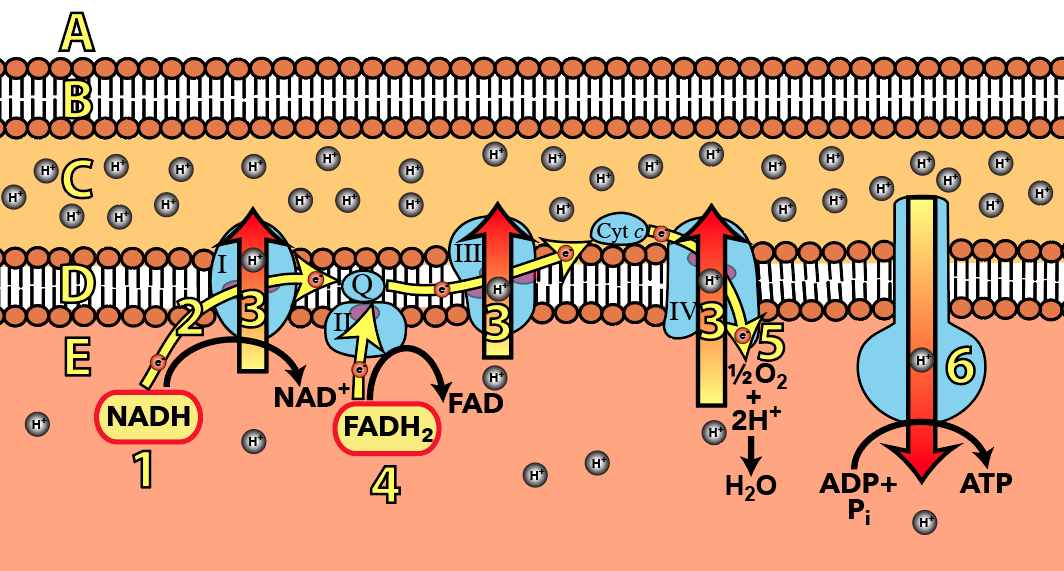
membrane) to the intermembrane space (shown above the inner membrane). In this diagram, proton pumps are indicated by the number “3”, and there are three different ones shown: one in Complex I, one in Complex III, and one in Complex IV.
All of these pumps are doing the same thing, and they’re all powered by the same energy source: the flow of electrons along the electron pathway (at number “2”). Note that this is active transport: the pumps are pumping up a concentration gradient from where protons are less concentrated (in the matrix) to where they’re more concentrated (in the intermembrane space).
5. It ends with making ATP by chemiosmosis
Pumping protons from the matrix (E, above) to the intermembrane space (C) creates a potential energy gradient that the cell harvests to make ATP. Because protons are charged particles, they can’t diffuse through the hydrophobic inner portion of the phospholipid bilayer. Consequently, once protons are pumped into the intermembrane space, they’re trapped there.
The energy gradient is a diffusion gradient, caused by the pumping of protons into the intermembrane space (“3”) and the removal of protons from the matrix during the reduction of oxygen to water (“5”). It’s also a voltage gradient. The positively charged protons are motivated to get out of the positively charged intermembrane space (because like charges repel) and into the more negatively charged matrix (because opposite charges attract).
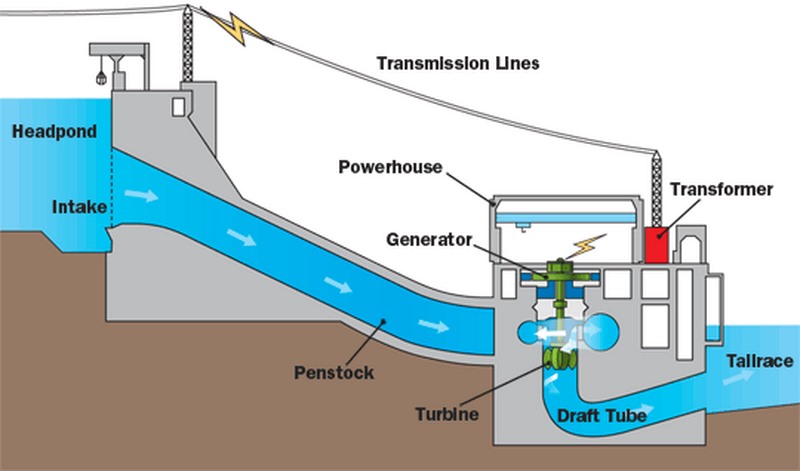 You can think of these trapped protons as being like water trapped behind a dam. In the diagram at right, the water behind the dam is stored in a headpond. When the intake is opened, that water flows through a channel (the penstock) which brings it to a turbine. The force of the water flowing through the turbine forces the turbine to rotate, which powers an electrical generator.
You can think of these trapped protons as being like water trapped behind a dam. In the diagram at right, the water behind the dam is stored in a headpond. When the intake is opened, that water flows through a channel (the penstock) which brings it to a turbine. The force of the water flowing through the turbine forces the turbine to rotate, which powers an electrical generator.
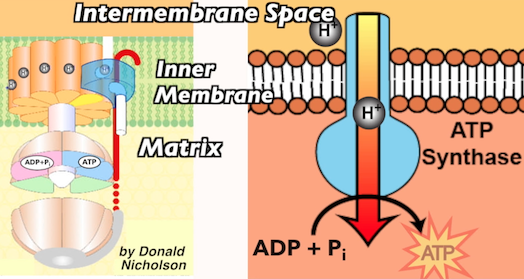 In cells, the protons in the intermembrane space are like the water in the headpond. There’s only one way for protons to get back to the matrix, and that’s through a protein channel and an enzyme called ATP synthase. ATP synthase has binding sites for ADP and Pi (inorganic phosphate). When protons diffuse through ATP synthase, their kinetic energy (energy of motion) causes these binding sites to change shape. This catalyzes the formation of a bond between ADP and Pi, transforming them into ATP.
In cells, the protons in the intermembrane space are like the water in the headpond. There’s only one way for protons to get back to the matrix, and that’s through a protein channel and an enzyme called ATP synthase. ATP synthase has binding sites for ADP and Pi (inorganic phosphate). When protons diffuse through ATP synthase, their kinetic energy (energy of motion) causes these binding sites to change shape. This catalyzes the formation of a bond between ADP and Pi, transforming them into ATP.
Here’s how I describe this process in my Electron Transport Chain music video:
ATP synthase is embedded in the inner membrane
How it works is so cool it’s insane.
It’s got channels for diffusing protons running right through it.
When cells make ATP, well watch how they do itThe matrix side of ATP synthase has binding sites
For ADP and P which come in and bind.
And as ATP synthase lets protons barge through
Their kinetic energy gets put to use.Like water through a turbine proton movement generates rotation.
Changing synthase’s binding site conformation.
Which catalyzes chemical bond formation.
ADP and P make ATP that energy sensation!
There are a few important biology-vocabulary terms that are connected with this process that you have to know.
- Chemiosmosis: the generation of ATP by the movement of protons from the intermembrane space across the inner mitochondrial membrane (through ATP synthase) during cellular respiration (adapted from Wikipedia).
- Oxidative phosphorylation is the process in which ATP is formed as a result of the transfer of electrons from NADH or FADH2 to O2 by a series of electron carriers (adapted from Biochemistry, 5th edition)
- Proton-motive force is the potential energy stored as a combination of proton and voltage (electrical potential) gradients across the inner membrane of the mitochondrion (see Wikipedia reference above)
6. The Electron Transport Chain Song
If you know what’s in this song, you’re set!
7. The Electron Transport Chain can also be used to generate heat (instead of ATP)
During non-shivering thermogenesis, the flow of electrons along the ETC generates heat: just imagine electricity flowing through the high resistance wires in a toaster, and you’ll have the idea.
Newborn and hibernating mammals have brown fat, the cells of which are dense with mitochondria (which is why it’s brown). When the animal needs to generate body heat, hormonal signals induce a proton channel called thermogenin to form in the inner mitochondrial membrane. This channel lets protons diffuse back to the matrix from the intermembrane space without passing through ATP synthase.
8. Quiz. The Electron Transport Chain
Got it? Start with the following quiz.
[qwiz random = “true” qrecord_id=”sciencemusicvideosMeister1961-ETC Quiz (2.0)”]
[h]Quiz: The electron transport chain
[i]
[q]In the diagram below, which number represents the part where you’d find ATP synthase?
[textentry single_char=”true”]
[c]Ng ==[Qq]
[f]IFllcywg4oCcNuKAnSBpcyB0aGUgaW5uZXIgbWl0b2Nob25kcmlhbCBtZW1icmFuZSwgd2hpY2ggaXMgd2hlcmUgQVRQIHN5bnRoYXNlIGlzIGxvY2F0ZWQu[Qq]
[c]Kg==[Qq]
[f]Tm8uIEhlcmUmIzgyMTc7cyBhIGhpbnQuIEFUUCBzeW50aGFzZSBnZW5lcmF0ZXMgQVRQIGFzIHByb3RvbnMgZmxvdyBmcm9tIHRoZSBpbnRlcm1lbWJyYW5lIHNwYWNlIHRvIHRoZSBtYXRyaXguIFdoZXJlIHdvdWxkIEFUUCBzeW50aGFzZSBoYXZlIHRvIGJlIGxvY2F0ZWQgdG8gYWxsb3cgZm9yIHRoaXM/
Cg==
[q]In the diagram below, which number represents the part where you’d find the electron transport chain?
[textentry single_char=”true”]
[c]Ng ==[Qq]
[f]IFllcywg4oCcNuKAnSBpcyB0aGUgaW5uZXIgbWl0b2Nob25kcmlhbCBtZW1icmFuZSwgd2hpY2ggaXMgd2hlcmUgdGhlIGVsZWN0cm9uIHRyYW5zcG9ydCBjaGFpbiBpcyBsb2NhdGVkLg==[Qq]
[c]Kg==[Qq]
[f]Tm8uIEhlcmUmIzgyMTc7cyBhIGhpbnQuIFRoZSBlbGVjdHJvbiB0cmFuc3BvcnQgY2hhaW4gcHVtcHMgcHJvdG9ucyBmcm9tIHRoZSBtYXRyaXggdG8gdGhlIGludGVybWVtYnJhbmUgc3BhY2UuIFdoZXJlIHdvdWxkIGl0IGhhdmUgdG8gYmUgbG9jYXRlZCB0byBhbGxvdyBmb3IgdGhpcz8=
Cg==
[q]In the diagram below, which number represents the area that protons get pumped into?
[textentry single_char=”true”]
[c]Nw ==[Qq]
[f]IFllcy4g4oCcN+KAnSBpcyB0aGUgaW50ZXJtZW1icmFuZSBzcGFjZSwgd2hpY2ggaXMgd2hlcmUgcHJvdG9ucyBnZXQgcHVtcGVkIHRvIGNyZWF0ZSBhIGNvbmNlbnRyYXRpb24gZ3JhZGllbnQgZm9yIHN5bnRoZXNpemluZyBBVFAu[Qq]
[c]Kg==[Qq]
[f]Tm8uIEhlcmUmIzgyMTc7cyBhIGhpbnQuIFRoZSBwcm90b25zIHN0YXJ0IGluIHRoZSBtYXRyaXguIFdoZXJlIGNvdWxkIHRoZXkgZ28gdG8gY3JlYXRlIGEgY29uY2VudHJhdGlvbiBncmFkaWVudCBmb3Igc3ludGhlc2l6aW5nIEFUUD8=
Cg==[Qq]
[q]In the diagram below, which number represents the area that protons flow to as they flow through ATP synthase, making ATP?
[textentry single_char=”true”]
[c]NQ ==[Qq]
[f]IFllcy4g4oCcNeKAnSBpcyB0aGUgbWF0cml4LCB3aGljaCBpcyB3aGVyZSBwcm90b25zIGZsb3cgYXMgdGhleSBmbG93IGZyb20gdGhlIGludGVybWVtYnJhbmUgc3BhY2UsIHRocm91Z2ggQVRQIHN5bnRoYXNlLCBpbnRvIHRoZSBtYXRyaXgu[Qq]
[c]Kg==[Qq]
[f]Tm8uIEhlcmUmIzgyMTc7cyBhIGhpbnQuIFRoZSBwcm90b25zIGhhdmUgYmVlbiBwdW1wZWQgdG8gdGhlIGludGVybWVtYnJhbmUgc3BhY2UuIFRoZSBvdXRlciBtZW1icmFuZSBpcyBpbXBlcm1lYWJsZSB0byBwcm90b25zLiBTbyBpcyB0aGUgaW5uZXIgbWVtYnJhbmUsIGV4Y2VwdCBmb3IgdGhlIEFUUCBzeW50aGFzZSBjaGFubmVsLiBJZiB0aGUgcHJvdG9ucyBmbG93IHRocm91Z2ggQVRQIHN5bnRoYXNlLCB3aGVyZSBhcmUgdGhleSBnb2luZyB0byB3aW5kIHVwPw==
Cg==[Qq]
[q]In the diagram below, where is NADH oxidized?
[textentry single_char=”true”]
[c]Ng ==[Qq]
[f]IFllcy4g4oCcNuKAnSBpcyB0aGUgaW5uZXIgbWVtYnJhbmUsIHdoaWNoIGlzIHdoZXJlIE5BREggaXMgb3hpZGl6ZWQsIGdpdmluZyB1cCBpdHMgZWxlY3Ryb25zIHRvIHRoZSBlbGVjdHJvbiB0cmFuc3BvcnQgY2hhaW4u[Qq]
[c]Kg==[Qq]
[f]Tm8uIEhlcmUmIzgyMTc7cyBhIGhpbnQuIFdoZW4gTkFESCBpcyBveGlkaXplZCwgaXQgZ2l2ZXMgdXAgZW5lcmdldGljIGVsZWN0cm9ucyB0aGF0IGZsb3cgYWxvbmcgdGhlIGVsZWN0cm9uIHRyYW5zcG9ydCBjaGFpbi4gV2hlcmUgaXMgdGhlIGVsZWN0cm9uIHRyYW5zcG9ydCBjaGFpbiBsb2NhdGVkPw==[Qq]
[q]Within the mitochondria, where is NAD+ reduced to NADH?
[textentry single_char=”true”]
[c]NQ ==[Qq]
[f]IFllcy4g4oCcNeKAnSBpcyB0aGUgbWF0cml4LiBEdXJpbmcgYm90aCB0aGUgbGluayByZWFjdGlvbiBhbmQgdGhlIEtyZWJzIGN5Y2xlLCBOQUQ=Kw==IGdldHMgcmVkdWNlZCB0byBOQURILCBhbmQgYm90aCB0aGVzZSBwcm9jZXNzZXMgb2NjdXIgaW4gdGhlIG1pdG9jaG9uZHJpYWwgbWF0cml4Lg==[Qq]
[c]Kg==[Qq]
[f]Tm8uIEhlcmUmIzgyMTc7cyBhIGhpbnQuIFR3byBwcm9jZXNzZXMgd2l0aGluIHRoZSBtaXRvY2hvbmRyaWEgcmVkdWNlIE5BRA==Kw==IHRvIE5BREguIFRoZXNlIGFyZSB0aGUgbGluayByZWFjdGlvbiBhbmQgdGhlIEtyZWJzIGN5Y2xlLiBXaGVyZSB3aXRoaW4gdGhlIG1pdG9jaG9uZHJpYSBkbyB0aGVzZSBwcm9jZXNzZXMgb2NjdXI/
Cg==[Qq]
[q]Which number or letter below represents the electron transport chain?
[textentry single_char=”true”]
[c]Mg ==[Qq]
[f]IFllcy4g4oCcMuKAnSByZXByZXNlbnRzIHRoZSBlbGVjdHJvbiB0cmFuc3BvcnQgY2hhaW4u[Qq]
[c]Kg==[Qq]
[f]Tm8uIEhlcmUmIzgyMTc7cyBhIGhpbnQuIEVsZWN0cm9ucyBhcmUgZG9uYXRlZCBieSBOQURIIGFuZCBGQURIMg==LiBXaGljaCBwYXJ0IG9mIHRoZSBkaWFncmFtIGNvdWxkIHJlcHJlc2VudCB0aGUgZmxvdyBvZiB0aGVzZSBlbGVjdHJvbnMgdGhyb3VnaCB0aGUgaW5uZXIgbWl0b2Nob25kcmlhbCBtZW1icmFuZT8=
Cg==[Qq]
[q]Which number or letter below shows active transport?
[textentry single_char=”true”]
[c]Mw ==[Qq]
[f]IFllcy4g4oCcM+KAnSByZXByZXNlbnRzIHRoZSBhY3RpdmUgdHJhbnNwb3J0IG9mIHByb3RvbnMgZnJvbSB0aGUgbWF0cml4ICh3aGVyZSB0aGV5JiM4MjE3O3JlIGluIGxvd2VyIGNvbmNlbnRyYXRpb24pIHRvIHRoZSBpbnRlcm1lbWJyYW5lIHNwYWNlICh3aGVyZSB0aGV5JiM4MjE3O3JlIGluIGhpZ2hlciBjb25jZW50cmF0aW9uKQ==[Qq]
[c]Kg==[Qq]
[f]Tm8uIEhlcmUmIzgyMTc7cyBhIGhpbnQuIEFjdGl2ZSB0cmFuc3BvcnQgaXMgdXAgYSBjb25jZW50cmF0aW9uIGdyYWRpZW50LiBFeGFtaW5lIHRoZSBtYXRyaXggYW5kIHRoZSBpbnRlcm1lbWJyYW5lIHNwYWNlLiBXaGVyZSBkbyB5b3Ugc2VlIHNvbWV0aGluZyBnZXR0aW5nIHB1bXBlZCBmcm9tIGxvd2VyIGNvbmNlbnRyYXRpb24gdG8gaGlnaGVyIGNvbmNlbnRyYXRpb24/
Cg==[Qq]
[q]Which number or letter below shows ATP synthase?
[textentry single_char=”true”]
[c]Ng ==[Qq]
[f]IFllcy4g4oCcNuKAnSByZXByZXNlbnRzIEFUUCBzeW50aGFzZS4=[Qq]
[c]Kg==[Qq]
[f]Tm8uIEhlcmUmIzgyMTc7cyBhIGhpbnQuIEFUUCBzeW50aGFzZSBpcyBib3RoIGFuIGVuenltZSB0aGF0IG1ha2VzIEFUUCBhbmQgYSBwcm90b24gY2hhbm5lbC4gV2hpY2ggcGFydCBvZiB0aGUgZGlhZ3JhbSBjb3VsZCBiZSBib3RoIG9mIHRoZXNlIHRoaW5ncz8=
Cg==[Qq]
[q]Which letter or number represents a region that would have the lowest pH?
[textentry single_char=”true”]
[c]Qw ==[Qq]
[f]IFllcy4g4oCcQ+KAnSBpcyB0aGUgaW50ZXJtZW1icmFuZSBzcGFjZS4gVGhlIGFjY3VtdWxhdGlvbiBvZiBwcm90b25zIGluIHRoaXMgYXJlYSB3b3VsZCBnaXZlIGl0IHRoZSBsb3dlc3QgcEggb2YgYW55IGFyZWEgd2l0aGluIHRoZSBtaXRvY2hvbmRyaW9uLg==[Qq]
[c]Kg==[Qq]
[f]Tm8uIEhlcmUmIzgyMTc7cyBhIGhpbnQuIHBIIGlzIGEgbWVhc3VyZSBvZiBoeWRyb2dlbiBpb24gY29uY2VudHJhdGlvbi4gV2hpY2ggcmVnaW9uIGhhcyBhIGxvdCBvZiBoeWRyb2dlbiBpb25zIChvciBwcm90b25zKSwgYW5kIHdvdWxkIHRoZXJlZm9yZSBoYXZlIGEgbG93ZXJlZCBwSD8=
Cg==[Qq]
[q]Which letter or number best represents “proton-motive force?”
[textentry single_char=”true”]
[c]Ng ==[Qq]
[f]IFllcy4g4oCcNuKAnSBzaG93cyBwcm90b25zIGRpZmZ1c2luZyBmcm9tIHRoZSBpbnRlcm1lbWJyYW5lIHNwYWNlLCB0aHJvdWdoIEFUUCBzeW50aGFzZSwgaW50byB0aGUgbWF0cml4LiBUaGlzIGRpZmZ1c2lvbiBkcml2ZXMgdGhlIHN5bnRoZXNpcyBvZiBBVFAgZnJvbSBBRFAgYW5kIFBpLCBhbmQgdGhlIGZvcmNlIHRoYXQgbWFrZXMgdGhpcyBwb3NzaWJsZSBpcyAmIzgyMjA7cHJvdG9uIG1vdGl2ZSBmb3JjZS4mIzgyMjE7[Qq]
[c]Kg==[Qq]
[f]Tm8uIEhlcmUmIzgyMTc7cyBhIGhpbnQuIFByb3Rvbi1tb3RpdmUgZm9yY2UgaXMgdGhlIGZvcmNlIHRoYXQgZHJpdmVzIEFUUCBzeW50aGVzaXMgYXMgcHJvdG9ucyBkaWZmdXNlIGZyb20gdGhlIGludGVybWVtYnJhbmUgc3BhY2UgaW50byB0aGUgbWF0cml4LiBXaGljaCBudW1iZXIgc2hvd3MgdGhpcyBoYXBwZW5pbmc/
Cg==[Qq]
[q]Which letter or number shows a process that does not involve pumping and which lowers the proton concentration in the matrix?
[textentry single_char=”true”]
[c]NQ ==[Qq]
[f]IFllcy4g4oCcNeKAnSBzaG93cyBveHlnZW4tYWJzb3JiaW5nIGVsZWN0cm9ucyBmcm9tIHRoZSBlbGVjdHJvbiB0cmFuc3BvcnQgY2hhaW4gYW5kIHByb3RvbnMgKEg=Kw==KSBmcm9tIHRoZSBtYXRyaXguIFRoaXMgbG93ZXJzIHRoZSBwcm90b24gY29uY2VudHJhdGlvbiBpbiB0aGUgbWF0cml4LCBpbmNyZWFzaW5nIHRoZSBjb25jZW50cmF0aW9uIGdyYWRpZW50IHRoYXQgZHJpdmVzIEFUUCBzeW50aGVzaXMgYXMgcHJvdG9ucyBkaWZmdXNlIHRocm91Z2ggdGhlIEFUUCBzeW50aGFzZS4=[Qq]
[c]Kg==[Qq]
[f]Tm8uIExvb2sgY2xvc2VseSBhdCB0aGUgZGlhZ3JhbS4gVGhlcmUmIzgyMTc7cyBvbmx5IG9uZSBwbGFjZSB3aGVyZSBwcm90b25zIGFyZSBiZWluZyBhYnNvcmJlZCBieSB0aGUgbWF0cml4LCBhbmQgaXQmIzgyMTc7cyBhdCB0aGUgdmVyeSBlbmQgb2YgdGhlIGVsZWN0cm9uIHRyYW5zcG9ydCBjaGFpbiAoaXQmIzgyMTc7cyBub3QgJiM4MjIwOzMsJiM4MjIxOyB3aGljaCBpbnZvbHZlcyBwdW1waW5nKS4=
Cg==[Qq]
[q]At numbers 1 and 4, mobile electron carriers are being
[c]b3hpZG l6ZWQg[Qq][c]cmVkdWNlZCA=[Qq][c]cGhvc3Bob3J5bGF0ZWQ=[Qq]
[f]IFllcy4gQXMgTkFESCBhbmQgRkFESA==Mg==IGJyaW5nIGVsZWN0cm9ucyB0byB0aGUgZWxlY3Ryb24gdHJhbnNwb3J0IGNoYWluLCB0aGV5IGJlY29tZSBveGlkaXplZCB0byBOQUQ=Kw==IGFuZCBGQUQu[Qq]
[f]Tm8uIFJlZHVjdGlvbiBpcyB0aGUgZ2FpbiBvZiBlbGVjdHJvbnMuIEZvciBleGFtcGxlLCB3aGVuIE5BRA==Kw==IGJlY29tZXMgTkFESCwgdGhhdCYjODIxNztzIGEgcmVkdWN0aW9uLg==[Qq]
[f]Tm8uIFBob3NwaG9yeWxhdGlvbiBpcyB0aGUgZ2FpbiBvZiBhIHBob3NwaGF0ZSBncm91cC4gVGhhdCYjODIxNztzIG5vdCB3aGF0JiM4MjE3O3MgaGFwcGVuaW5nIGhlcmUu
Cg==[Qq]
[q]What’s happening at “6” in the diagram below is
[c]b3hpZGF0aW9u[Qq]
[c]cmVkdWN0aW9u[Qq]
[c]c3Vic3RyYXRlIGxldmVsIHBob3NwaG9yeWxhdGlvbg==[Qq]
[c]b3hpZGF0aXZlIHBob3 NwaG9yeWxhdGlvbg==[Qq]
[f]Tm8uIE94aWRhdGlvbiBpcyB0aGUgbG9zcyBvZiBlbGVjdHJvbnMuIExvb2sgY2xvc2VseSBhdCB3aGF0JiM4MjE3O3MgaGFwcGVuaW5nIGF0ICYjODIyMDs2LiYjODIyMTsgTm90aWNlIHRoYXQgaXQgaW52b2x2ZXMgYSBwaG9zcGhhdGUgKHdoaWNoIGlzIGEgYmlnIGhpbnQpLg==[Qq]
[f]Tm8uIFJlZHVjdGlvbiBpcyB0aGUgZ2FpbiBvZiBlbGVjdHJvbnMuIExvb2sgY2xvc2VseSBhdCB3aGF0JiM4MjE3O3MgaGFwcGVuaW5nIGF0ICYjODIyMDs2LiYjODIyMTsgTm90aWNlIHRoYXQgaXQgaW52b2x2ZXMgYSBwaG9zcGhhdGUgKHdoaWNoIGlzIGEgYmlnIGhpbnQpLg==[Qq]
[f]Tm8uIFN1YnN0cmF0ZSBsZXZlbCBwaG9zcGhvcnlsYXRpb24gaW52b2x2ZXMgZW56eW1lcyB0aGF0IHRyYW5zZmVyIGEgcGhvc3BoYXRlIGZyb20gYW4gb3JnYW5pYyBzdWJzdHJhdGUgYW5kIHBsYWNlIGl0IG9udG8gQURQLCBtYWtpbmcgQVRQLiAmIzgyMjA7NiYjODIyMTsgaXMgcGhvc3Bob3J5bGF0aW9uLCBidXQgaXQmIzgyMTc7cyBub3QgJiM4MjIwO3N1YnN0cmF0ZS1sZXZlbCYjODIyMTs=[Qq]
[f]WWVzLiBUaGUgcGhvc3Bob3J5bGF0aW9uIHRoYXQgaGFwcGVucyBhdCBBVFAgc3ludGhhc2UgaXMgY2FsbGVkICYjODIyMDtveGlkYXRpdmUgcGhvc3Bob3J5bGF0aW9uLCYjODIyMTsgYmVjYXVzZSBpdCByZXF1aXJlcyB0aGUgcHJlc2VuY2Ugb2Ygb3h5Z2VuIHRvIHBvd2VyIHRoZSBlbGVjdHJvbiB0cmFuc3BvcnQgY2hhaW4u[Qq]
[q]Which letter or number shows where substrate-level phosphorylations are occurring within the mitochondria?
[textentry single_char=”true”]
[c]RQ ==[Qq]
[f]IFllcy4g4oCcReKAnSBpcyB0aGUgbWF0cml4LiBXaXRoaW4gdGhlIG1hdHJpeCwgdGhlIEtyZWJzIGN5Y2xlIGNhcnJpZXMgb3V0IG9uZSBzdWJzdHJhdGUgcGhvc3Bob3J5bGF0aW9uIGZvciBlYWNoIGFjZXR5bCBncm91cCB0aGF0IGlzIGJyb3VnaHQgaW50byB0aGUgY3ljbGUu[Qq]
[c]Kg==[Qq]
[f]Tm8uIEhlcmUmIzgyMTc7cyBhIGhpbnQuIFN1YnN0cmF0ZSBsZXZlbCBwaG9zcGhvcnlsYXRpb25zIG9jY3VyIGR1cmluZyB0aGUgS3JlYnMgY3ljbGUuIFdoZXJlIGRvZXMgdGhlIEtyZWJzIGN5Y2xlIG9jY3VyPw==[Qq]
[q]Of the following protein complexes, which must have the most electronegative electron carriers?
[c]SSA=[Qq][c]SUkg[Qq][c]SUlJIA==[Qq][c]SV Y=[Qq]
[f]IE5vLiBUaGUgZWxlY3Ryb24gY2FycmllcnMgaW4gdGhlIGVsZWN0cm9uIHRyYW5zcG9ydCBjaGFpbiBhcmUgb3JnYW5pemVkIGluIG9yZGVyIG9mIGluY3JlYXNpbmcgZWxlY3Ryb25lZ2F0aXZpdHkuIENvbXBsZXggSSBpcyB0aGUgbGVhc3Q=IGVsZWN0cm9uZWdhdGl2ZS4=[Qq]
[f]IE5vLiBUaGUgZWxlY3Ryb24gY2FycmllcnMgaW4gdGhlIGVsZWN0cm9uIHRyYW5zcG9ydCBjaGFpbiBhcmUgb3JnYW5pemVkIGluIG9yZGVyIG9mIGluY3JlYXNpbmcgZWxlY3Ryb25lZ2F0aXZpdHkuIENvbXBsZXggSSBpcyB0aGUgbGVhc3Q=IGVsZWN0cm9uZWdhdGl2ZS4gV2hpY2ggb25lIHdvdWxkIGJlIHRoZSBtb3N0Pw==[Qq]
[f]IE5vLiBUaGUgZWxlY3Ryb24gY2FycmllcnMgaW4gdGhlIGVsZWN0cm9uIHRyYW5zcG9ydCBjaGFpbiBhcmUgb3JnYW5pemVkIGluIG9yZGVyIG9mIGluY3JlYXNpbmcgZWxlY3Ryb25lZ2F0aXZpdHkuIENvbXBsZXggSSBpcyB0aGUgbGVhc3Q=IGVsZWN0cm9uZWdhdGl2ZS4gV2hpY2ggb25lIHdvdWxkIGJlIHRoZSBtb3N0Pw==[Qq]
[f]IFllcy4gVGhlIGVsZWN0cm9uIGNhcnJpZXJzIGluIHRoZSBlbGVjdHJvbiB0cmFuc3BvcnQgY2hhaW4gYXJlIG9yZ2FuaXplZCBpbiBvcmRlciBvZiBpbmNyZWFzaW5nIGVsZWN0cm9uZWdhdGl2aXR5LiBDb21wbGV4IEkgaXMgdGhlIA==bGVhc3Q=IGVsZWN0cm9uZWdhdGl2ZSwgYW5kIGNvbXBsZXggSVYgaXMgdGhlIG1vc3QgZWxlY3Ryb25lZ2F0aXZlLg==
[/qwiz]
9. Electron Transport Chain: Karaoke Version
Can you sing it?
What’s next
- Proceed to Topic 3.6, part 5: Anaerobic Respiration/Fermentation (the next topic in AP Bio Unit 3).
